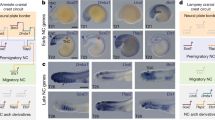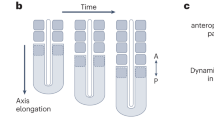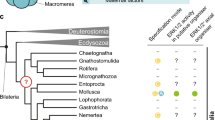Abstract
The roof plate is an embryonic organizing centre that occupies the dorsal midline of the vertebrate neural tube. During early CNS development, the roof plate produces secreted factors, which control the specification and differentiation of dorsal neuronal cell types. An appreciation of the signalling properties of the roof plate has prompted an enhanced interest in this important organizing centre, and several recent studies have begun to illuminate the molecular mechanisms of roof plate development.
This is a preview of subscription content, access via your institution
Access options
Subscribe to this journal
Receive 12 print issues and online access
$189.00 per year
only $15.75 per issue
Buy this article
- Purchase on Springer Link
- Instant access to full article PDF
Prices may be subject to local taxes which are calculated during checkout



Similar content being viewed by others
References
Lee, K. J. & Jessell, T. M. The specification of dorsal cell fates in the vertebrate central nervous system. Annu. Rev. Neurosci. 22, 261–294 (1999).
Jessell, T. M. Neuronal specification in the spinal cord: inductive signals and transcriptional codes. Nature Rev. Genet. 1, 20–29 (2000).
Shirasaki, R. & Pfaff, S. L. Transcriptional codes and the control of neuronal identity. Annu. Rev. Neurosci. 25, 251–281 (2002).
Marti, E. & Bovolenta, P. Sonic hedgehog in CNS development: one signal, multiple outputs. Trends Neurosci. 25, 89–96 (2002).
Lee, K. J., Dietrich, P. & Jessell, T. M. Genetic ablation reveals that the roof plate is essential for dorsal interneuron specification. Nature 403, 734–740 (2000).
Millonig, J. H., Millen, K. J. & Hatten, M. E. The mouse Dreher gene Lmx1a controls formation of the roof plate in the vertebrate CNS. Nature 403, 764–769 (2000).
Liem, K. F., Tremml, G. & Jessell, T. M. A role for the roof plate and its resident TGFβ-related proteins in neuronal patterning in the dorsal spinal cord. Cell 91, 127–138 (1997).
Lee, K. J., Mendelsohn, M. & Jessell, T. M. Neuronal patterning by BMPs: a requirement for GDF7 in the generation of a discrete class of commissural interneurons in the mouse spinal cord. Genes Dev. 12, 3394–3407 (1998).
Timmer, J. R., Wang, C. & Niswander, L. BMP signaling patterns the dorsal and intermediate neural tube via regulation of homeobox and helix–loop–helix transcription factors. Development 129, 2459–2472 (2002).
Muroyama, Y., Fujihara, M., Ikeya, M., Kondoh, H. & Takada, S. Wnt signaling plays an essential role in neuronal specification of the dorsal spinal cord. Genes Dev. 16, 548–553 (2002).
Chizhikov, V. V. & Millen, K. J. Control of roof plate formation by Lmx1a in the developing spinal cord. Development 131, 2693–2705 (2004).
Chizhikov, V. V. & Millen, K. J. Control of roof plate development and signaling by Lmx1b in the caudal vertebrate CNS. J. Neurosci. 24, 5694–5703 (2004).
Liu, Y., Helms, A. W. & Johnson, J. E. Distinct activities of Msx1 and Msx3 in dorsal neural tube development. Development 131, 1017–1028 (2004).
Megason, S. G. & McMahon, A. P. A mitogen gradient of dorsal midline Wnts organizes growth in the CNS. Development 129, 2087–2098 (2002).
Millen, K. J., Millonig, J. H. & Hatten, M. E. Roof plate and dorsal spinal cord dl1 interneuron development in the dreher mutant mouse. Dev. Biol. 270, 382–392 (2004).
Augsburger, A., Schuchardt, A., Hoskins, S., Dodd, J. & Butler, S. BMPs as mediators of roof plate repulsion of commissural neurons. Neuron 24, 127–141 (1999).
Butler, S. J. & Dodd, J. A role for BMP heterodimers in roof plate-mediated repulsion of commissural axons. Neuron 38, 389–401 (2003).
Kahane, N. & Kalcheim, C. Identification of early postmitotic cells in distinct embryonic sites and their possible roles in morphogenesis. Cell Tissue Res. 294, 297–307 (1998).
Luo, G. et al. BMP-7 is an inducer of nephrogenesis, and is also required for eye development and skeletal patterning. Genes Dev. 9, 2808–2820 (1995).
Dudley, A. T., Lyons, K. M. & Robertson, E. J. A requirement for bone morphogenetic protein-7 during development of the mammalian kidney and eye. Genes Dev. 9, 2795–2807 (1995).
Zhang, H. & Bradley, A. Mice deficient for BMP2 are nonviable and have defects in amnion/chorion and cardiac development. Development 122, 2977–2986 (1996).
Winnier, G., Blessing, M., Labosky, P. A. & Hogan, B. L. Bone morphogenetic protein-4 is required for mesoderm formation and patterning in the mouse. Genes Dev. 9, 2105–2116 (1995).
Hollyday, M., McMahon, J. A. & McMahon, A. P. Wnt expression patterns in chick embryo nervous system. Mech. Dev. 52, 9–25 (1995).
Garcia-Castro, M. I., Marcelle, C. & Bronner-Fraser, M. Ectodermal Wnt function as a neural crest inducer. Science 297, 848–851 (2002).
Wu, J., Saint-Jeannet, J. P. & Klein, P. S. Wnt-frizzled signaling in neural crest formation. Trends Neurosci. 26, 40–45 (2003).
Wilson, L., Gale, E., Chambers, D. & Maden, M. Retinoic acid and the control of dorsoventral patterning in the avian spinal cord. Dev. Biol. 269, 433–446 (2004).
Failli, V., Bachy, I. & Retaux, S. Expression of the LIM-homeodomain gene Lmx1a (dreher) during development of the mouse nervous system. Mech. Dev. 118, 225–228 (2002).
Hill, R. E. et al. A new family of mouse homeo box-containing genes: molecular structure, chromosomal location, and developmental expression of Hox-7.1. Genes Dev. 3, 26–37 (1989).
Robert, B., Sassoon, D., Jacq, B., Gehring, W. & Buckingham, M. Hox-7, a mouse homeobox gene with a novel pattern of expression during embryogenesis. EMBO J. 8, 91–100 (1989).
Shimeld, S. M., McKay, I. J. & Sharpe, P. T. The murine homeobox gene Msx-3 shows highly restricted expression in the developing neural tube. Mech. Dev. 55, 201–210 (1996).
Wang, W., Chen, X., Xu, H. & Lufkin, T. Msx3: a novel murine homologue of the Drosophila msh homeobox gene restricted to the dorsal embryonic central nervous system. Mech. Dev. 58, 203–215 (1996).
Bronner-Fraser, M. & Fraser, S. E. Cell lineage analysis reveals multipotency of some avian neural crest cells. Nature 335, 161–164 (1988).
Bronner-Fraser, M. & Fraser S. Developmental potential of avian trunk neural crest cells in situ. Neuron 3, 755–766 (1989).
Selleck, M. A. and Bronner-Fraser, M. Origins of the avian neural crest: the role of neural plate-epidermal interactions. Development 121, 525–538 (1995).
Knecht, A. K. & Bronner-Fraser, M. Induction of the neural crest: a multigene process. Nature Rev. Genet. 3, 453–461 (2002).
Helms, A. W. & Johnson, J. E. Progenitors of dorsal commissural interneurons are defined by MATH1 expression. Development 125, 919–928 (1998).
Manzanares, M., Trainor, P. A., Ariza-McNaughton, L., Nonchev, S. & Krumlauf, R. Dorsal patterning defects in the hindbrain, roof plate and skeleton in the dreher (dr(J)) mouse mutant. Mech. Dev. 94, 147–156 (2000).
Nieto, M. A., Sargent, M. G., Wilkinson, D. G. & Cooke, J. Control of cell behavior during vertebrate development by Slug, a zinc finger gene. Science 264, 835–839 (1994).
Liu, J. P. & Jessell, T. M. A role for rhoB in the delamination of neural crest cells from the dorsal neural tube. Development 125, 5055–5067 (1998).
Kos, R., Reedy, M. V., Johnson, R. L. & Erickson, C. A. The winged-helix transcription factor FoxD3 is important for establishing the neural crest lineage and repressing melanogenesis in avian embryos. Development 128, 1467–1479 (2001).
Dottori, M., Gross, M. K., Labosky, P. & Goulding, M. The winged-helix transcription factor Foxd3 suppresses interneuron differentiation and promotes neural crest cell fate. Development 128, 4127–4138 (2001).
Gammill, L. S. & Bronner-Fraser, M. Genomic analysis of neural crest induction. Development 129, 5731–5741 (2002).
Muller, T. et al. The homeodomain factor lbx1 distinguishes two major programs of neuronal differentiation in the dorsal spinal cord. Neuron 34, 551–562 (2002).
Gross, M. K., Dottori, M. & Goulding, M. Lbx1 specifies somatosensory association interneurons in the dorsal spinal cord. Neuron 34, 535–549 (2002).
Caspary, T. & Anderson, K. V. Patterning cell types in the dorsal spinal cord: what the mouse mutants say. Nature Rev. Neurosci. 4, 289–297 (2003).
Helms, A. W. & Johnson, J. E. Specification of dorsal spinal cord interneurons. Curr. Opin. Neurobiol. 13, 42–49 (2003).
Bergstrom, D. E., Gagnon, L. H. & Eicher, E. M. Genetic and physical mapping of the dreher locus on mouse chromosome 1. Genomics 59, 291–299 (1999).
Sekiguchi, M., Shimai, K., Guo, H. & Nowakowski, R. S. Cytoarchitectonic abnormalities in hippocampal formation and cerebellum of dreher mutant mouse. Brain Res. Dev. Brain Res. 67, 105–112 (1992).
Acknowledgements
We are grateful to A. Lindgren, I. Grinberg, C. Logan and E. Steshina for helpful discussion of the manuscript. This work was supported by grants from the Brain Research Foundation and the Whitehall Foundation.
Author information
Authors and Affiliations
Ethics declarations
Competing interests
The authors declare no competing financial interests.
Related links
Related links
DATABASES
Entrez Gene
FURTHER INFORMATION
Rights and permissions
About this article
Cite this article
Chizhikov, V., Millen, K. Mechanisms of roof plate formation in the vertebrate CNS. Nat Rev Neurosci 5, 808–812 (2004). https://doi.org/10.1038/nrn1520
Issue Date:
DOI: https://doi.org/10.1038/nrn1520
This article is cited by
-
Possibilities and limitations of three-dimensional reconstruction and simulation techniques to identify patterns, rhythms and functions of apoptosis in the early developing neural tube
History and Philosophy of the Life Sciences (2018)
-
Dynamics of BMP and Hes1/Hairy1 signaling in the dorsal neural tube underlies the transition from neural crest to definitive roof plate
BMC Biology (2016)
-
Retinoic acid is a potential dorsalising signal in the late embryonic chick hindbrain
BMC Developmental Biology (2007)
-
Molecular definition of an allelic series of mutations disrupting the mouse Lmx1a (dreher) gene
Mammalian Genome (2006)



